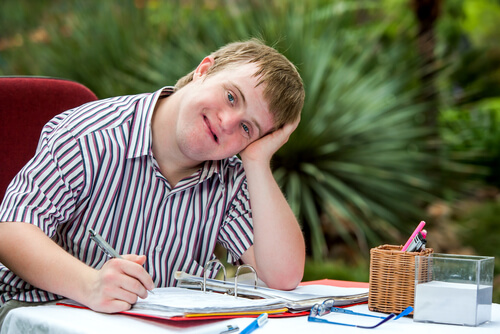
Page contents
- Difference between a learning disability and a learning difficulty
- Types of common learning difficulties
- What causes learning disabilities?
- How do learning disabilities affect people?
- Examples of learning disabilities with prenatal causes
- Examples of learning disabilities with perinatal causes
- Postnatal causes that can result in a learning disability
Page contents
- Difference between a learning disability and a learning difficulty
- Types of common learning difficulties
- What causes learning disabilities?
- How do learning disabilities affect people?
- Examples of learning disabilities with prenatal causes
- Examples of learning disabilities with perinatal causes
- Postnatal causes that can result in a learning disability
The definition of a learning disability is a condition that affects somebody’s ability to learn new knowledge or skills.
There are many types of learning disabilities. These can range from mild to severe in how much they affect a person, and they do not necessarily relate to a low IQ.
Many people with learning disabilities can live independently and have jobs and families, while others may need care and support throughout their lives.
Approximately 1.5 million people in the UK have a learning disability, which is a little over 2% of the population.
Difference between a learning disability and a learning difficulty
A learning difficulty is not the same thing as a learning disability. A learning difficulty can cause challenges with an aspect of learning. People with learning difficulties may not require as much support and someone with a learning disability.
Types of common learning difficulties
Dyslexia
People with dyslexia can have trouble with reading and writing. This is because they find it more difficult to connect verbal sounds and speech with written words and letters. When you read, the brain decodes the text so you know what each word sounds like and understand it. This decoding can be slower for people with dyslexia, as can translating their thoughts into written words.
Dyscalculia
Dyscalculia can cause people to struggle with maths. They can have difficulty with relating a number to its quantity, which presents problems with counting, sums and sequences. People with dyscalculia can also struggle with directions and telling the time.
Dysgraphia
This is a difficulty with writing. People with dysgraphia can find it hard to write in an orderly way. For example, their handwriting may be very difficult to read, have words or letters written in the wrong order or even the wrong way round, and they can find it difficult to write in lines.
Attention Deficit Hyperactivity Disorder (ADHD)
ADHD can mean that people with the condition have a short attention span and difficulty concentrating, often getting easily distracted. This can make learning, working and even conversation more challenging.
What causes learning disabilities?
Learning disabilities can be caused while a baby is in the womb (prenatal), during labour (perinatal) or at any point in a person’s life (postnatal). These are often referred to as the three main types of learning disabilities, and most recognised learning disabilities fall into one of these categories. They can be a result of health conditions or how the brain developed.
How do learning disabilities affect people?
Individuals who live with learning disabilities all have their own unique experience, but common effects of a learning disability include difficulties with spoken language, reading comprehension and problem solving.
Examples of learning disabilities with prenatal causes
Down’s Syndrome
In humans, when an egg is fertilised with sperm, 46 chromosomes are typically created. Down’s Syndrome is caused by an extra copy of Chromosome 21. Around 2% of these will have two or even three copies of Chromosome 21, a condition known as Mosaic Down’s Syndrome.
People who have Down’s Syndrome usually have distinctive facial features associated with the condition, in particular, eyes that slant upwards at the outer edges. They are often smaller than average in terms of height and their hands and feet. In terms of learning, Down’s Syndrome can affect a person’s abilities with speaking, literacy, maths and memory. Many people with Down’s Syndrome have support in education, working or organisation.
Williams Syndrome
This rare condition is caused by a person being born without at least 25 specific genes that are usually present in Chromosome 7. People with Williams Syndrome usually have ‘elfin’ facial features and often an excitable, outgoing and highly empathetic disposition. They can be very interested in other people, extremely friendly and have extraordinary memories. They can have difficulty with learning, and be slower in developing skills than other people.
Rett Syndrome
Rett Syndrome is caused by a mutation on a gene of the X Chromosome. The majority of people affected by the condition are female, because females have two X chromosomes while males have one X and one Y. It is a neurological and developmental condition, so despite being born with Rett Syndrome, people with it are actually affected more as they grow. Their abilities with movement and communication can decrease over time or be lost altogether.
Prader-Willi Syndrome
Prader-Willi Syndrome is caused by a fault in Chromosome 15, which can affect appetite and growth. It is not hereditary. People with the condition can have extreme appetites, as well as difficult behaviour in an attempt to fulfil their overwhelming desire to eat.
Most people with Prader-Willi Syndrome also have some level of learning difficulty or disability. As children they usually develop more slowly, both physically and in terms of academic and social skills, than other children.
Autism Spectrum Disorder
Autism is not a learning disability in itself. In fact, many people with autism have extremely high intelligence, but around half of people with the condition do have a learning disability. Autism is a neurological disorder whose cause is not clear, but researchers generally agree that it is to do with the genetic makeup of a person’s brain, and can be hereditary. It can affect a person’s abilities to form an understanding of what they are learning.
Around 1% of people have autism.
Examples of learning disabilities with perinatal causes
Cerebral palsy
Cerebral palsy is not a learning disability in itself and primarily affects movement. However, about 50% of people with cerebral palsy also have a learning disability, due to the nature of its cause.
Cerebral palsy can be caused prenatally, perinatally or postnatally. It happens when white matter in the brain is damaged. This damage could be caused by lack of blood supply, lack of oxygen, infection, stroke or injury.
Tourette’s Syndrome
Tourette’s Syndrome can develop before, during or after birth. Its exact cause is unknown, but it is a neurological condition that likely affects the parts of the brain that control movement and speech. People can be born with Tourette’s Syndrome or develop it due to trauma to the brain.
Even if the cause is prenatal or a trauma during labour, the symptoms usually only start to become apparent when a child is between aged 3 and 9 years old. People with Tourette’s Syndrome can have uncontrollable ‘tics’. These are involuntary body movements or verbal words, phrases or noises. They can become more intense when the person is stressed.
While Tourette’s Syndrome is not a learning disability, many people with the condition also have a learning difficulty or disability that affects their reading, writing or maths.
Postnatal causes that can result in a learning disability
Meningitis
Meningitis causes the lining around the brain and spinal cord to become inflamed. It is caused by a bacterial infection and can result in difficulties with hearing, behaviour and learning. Some people who have recovered from meningitis are left with a learning disability, while others can fully recover.
Trauma
Any brain trauma, such as an accident or swelling, can leave somebody with a learning disability. When a brain is injured, calls or neural pathways can die, resulting in reduced ability to function. Different parts of the brain control different functions so how brain injuries affect people varied widely. Some people may fully recover from trauma to the brain, while others can have difficulties for the rest of their lives.
Find your ideal care home
- Explore a wide range of care options and facilities
- Read independent ratings and reviews
- Connect directly with care homes to book a tour and discuss your needs


